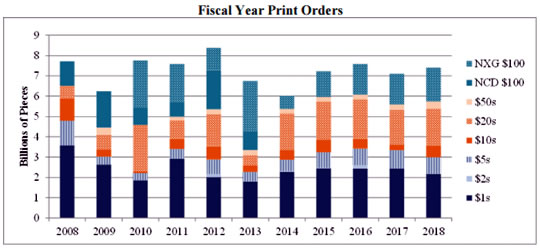
U.S. money production for 2018 is expected to exceed 7.4 billion banknotes valued at more than $233.3 billion, according to a Federal Reserve order submitted to the Bureau of Engraving and Printing (BEP).
Most of the notes will be $1s, $20s and $100s, and no $2s were requested for a second year in a row.
The figures come from a print order submitted by the Board of Governors of the Federal Reserve, the issuing authority for U.S. banknotes. It reflects the Board’s estimate of net demand for currency in FY 2018 from both domestic and international customers. The 7.4 billion total represents an increase of 300.8 million, or 4.2%, from the more than 7.1 billion notes ordered for FY 2017.
Based on the latest estimates, about 75% of the notes will be replacements for bills taken out of circulation because their condition no longer meets the criteria for recirculation or because they are of older designs. The replacement estimate was at 71% for FY 2017; 70% for FY 2016, and 85% for FY 2015.
Cost of Making Federal Reserve Notes
The BEP’s cost of producing money varies by banknote. For example, government figures for 2017 show production costs per note at:
- 5.4 cents for $1s and $2s — down from 5.5 cents in 2016.
- 11.5 cents for $5s — up from 10.9 cents in 2016.
- 10.9 cents for $10s — up from 10.3 cents in 2016.
- 12.2 cents for $20s — up from 10.6 cents in 2016.
- 19.4 cents for $50s — up from 10.6 cents in 2016.
- 15.5 cents for $100s — up from 14.3 cents in 2016.
The 2017 currency budget was $726.6 million.
No $2 Notes for 2018
Like in 2017, the latest order lacks $2s because the amount made in 2016 is expected to satisfy demand for multiple years, according to the official print order. For some perspectives, orders for $2s totaled:
- 44.8 million in 2014;
- 32 million in 2015; and
- 179.2 million in 2016.
Here is a table showing how the Fed’s order breaks down by face value, quantity and dollar value:
2018 Federal Reserve Note Print Order
| Denomination | Number of Notes (000s of pieces) |
Dollar Value (000s of dollars) |
|---|---|---|
| $1 | 2,169,600 | $2,169,600 |
| $2 | 0 | 0 |
| $5 | 825,600 | $4,128,000 |
| $10 | 569,600 | $5,696,000 |
| $20 | 1,804,800 | $36,096,000 |
| $50 | 364,800 | $18,240,000 |
| $100 | 1,670,400 | $167,040,000 |
| Total | 7,404,800 | $233,369,000 |
The BEP operates on a fiscal year that begins on Oct. 1 and ends on Sept. 30. They agency produces all U.S. banknotes, and the order for 2018 includes currency set aside for numismatic products.
For reference, this table shows the banknote order totals placed for fiscal year 2017:
2017 Federal Reserve Note Print Order
| Denomination | Number of Notes (000s of pieces) |
Dollar Value (000s of dollars) |
|---|---|---|
| $1 | 2,425,600 | $2,425,600 |
| $2 | 0 | 0 |
| $5 | 915,200 | $4,576,000 |
| $10 | 262,400 | $2,624,000 |
| $20 | 1,715,200 | $34,304,000 |
| $50 | 268,800 | $13,440,000 |
| $100 | 1,516,800 | $151,680,000 |
| Total | 7,104,000 | $209,049,000 |
Lastly, this Fed chart shows orders between FY 2008 and FY 2018:

The BEP produces banknotes at facilities in Fort Worth, TX and Washington, D.C. According to government data, there was approximately $1.58 trillion in circulation as of Sept. 20, 2017, of which $1.53 trillion was in Federal Reserve notes.






just print replacement notes if really necessary, forget about the 300.8 million increase.
I’m sure it’s a very good reason why it cost so much to print each note$, almost 51/2 cents to print 1 $2 & $! note, 11 1/2 for a $5, just shot of 11 cents for$10 note, 12 1/8 cents for one $20 bill, 1/8 under 20 cents for a $50 Grant greatest grand kids must be on the pall roll or something like that, 15 1/2 cents For Ben Franklin+*, stick with the 3 most cheapest to print $, $1*$2*$5*$10* you get two for the price of 1 With $1 & $2 notes, lol* that will work &… Read more »